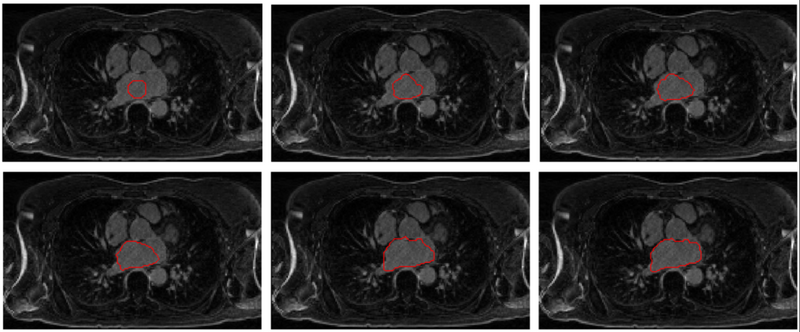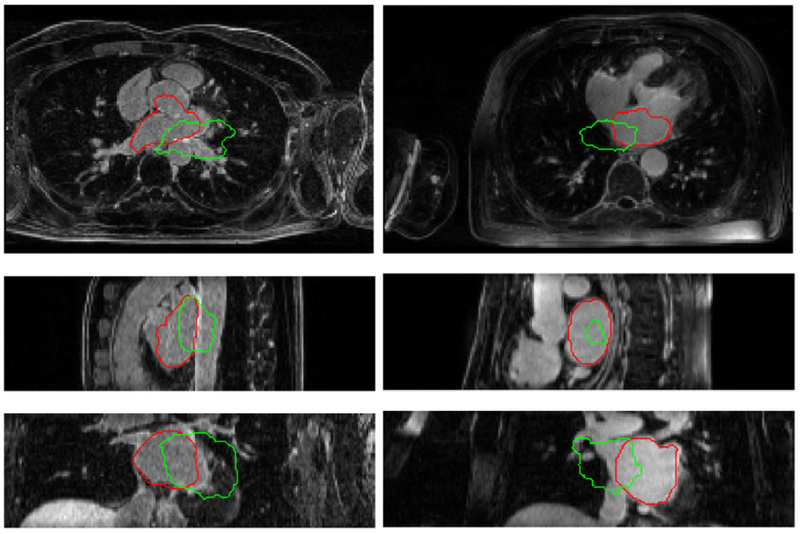Difference between revisions of "Projects:LeftAtriumSegmentation"
| (27 intermediate revisions by one other user not shown) | |||
| Line 1: | Line 1: | ||
| − | Back to [[Algorithm: | + | Back to [[Algorithm:Stony Brook|Stony Brook University Algorithms]] |
__NOTOC__ | __NOTOC__ | ||
| − | = Automatic Segmentation of Left Atrium | + | = Automatic Segmentation of Left Atrium via Variational Region Growing= |
| − | |||
| − | |||
= Description = | = Description = | ||
| + | Automatic segmentation of the left atrium (LA) from MRI data is a challenging but major task in medical imaging | ||
| + | analysis. An important application is concerned with the treatment of left atrial fibrillation [1]. Atrial fibrillation is a cardiac | ||
| + | arrhythmia characterized by unsynchronized electrical activity in the atrial chambers of the heart. One of the treatments | ||
| + | for such arrhythmia is the catheter ablation, which targets specific parts of the LA for radio-frequency ablation using | ||
| + | an intracardiac catheter [2]. Application of radio-frequency energy to the cardiac tissue causes thermal injury, which in | ||
| + | turn results into scar tissue. Successful ablation can eliminate, or isolate, the problematic sources of electrical activity and | ||
| + | effectively cure atrial fibrillation. In order to perform such ablation, the extraction of the LA from the late gadolinium | ||
| + | enhancement MR (LGE-MR) images is required and is often performed manually, which is a very time-consuming task. | ||
| + | However, automatic LA segmentation is challenging due to the following factors: 1) the LA sized is relatively small as | ||
| + | compared to the left ventricle (LV) or lungs in cardiac MRI images; 2) boundaries are not clearly defined when the blood | ||
| + | pool goes into the pulmonary veins from the LA; 3) the shape variability of LA is large across subjects. | ||
| + | |||
We propose an automatic approach for segmenting the left atrium from magnetic resonance imagery | We propose an automatic approach for segmenting the left atrium from magnetic resonance imagery | ||
(MRI). The segmentation problem is formulated as a problem in variational region growing. In particular, the method starts | (MRI). The segmentation problem is formulated as a problem in variational region growing. In particular, the method starts | ||
| Line 11: | Line 21: | ||
shape prior to the left atrium represented by Zernike moments. The overall growing process is guided by the robust statistics of | shape prior to the left atrium represented by Zernike moments. The overall growing process is guided by the robust statistics of | ||
intensities from the seed region along with the shape prior to capture the whole atrial region. | intensities from the seed region along with the shape prior to capture the whole atrial region. | ||
| + | |||
| + | The proposed method consists of two key steps: | ||
| + | *(1) search for a seed region of the LA from an image slice in the axial view. | ||
| + | |||
| + | *(2) explore the LA region using a variational region-growing process. A shape prior is employed to drive the growing process towards atrium-like shapes. | ||
| + | Given a properly set seed region, a growing process driven by the robust statistics of the seed region is employed to explore the entire LA region. However, leakage is almost | ||
| + | inevitable because the statistics computed does not provide a global shape constraint on evolving contours. Hence, a shape | ||
| + | prior is applied to attract the growing process towards an expected shape. | ||
| + | |||
| + | = Results = | ||
| + | *[[File:Image-LASegWithMomentsPrior.png|800px]] | ||
| + | Region-growing process driven by robust statistics and Zernike moments shape prior. | ||
| + | |||
| + | *[[File:LASegRG2Atlas.png|800px]] | ||
| + | Comparison of the worst results obtained using the proposed method (first column) and the atlas-based method (second column) . From top to bottom: | ||
| + | the LA returned using the proposed method (red) and atlas-based method (green) in axial, coronal, and sagittal views, respectively. | ||
| + | |||
| + | = Key Investigators = | ||
| + | *Georgia Tech: Liangjia Zhu and Anthony Yezzi | ||
| + | *BWH: Yi Gao | ||
| + | *Boston University: Allen Tannenbaum | ||
| + | |||
| + | = Publications = | ||
| + | L. Zhu, Y. Gao, A. Yezzi, R. MacLeod, J. Cates, A. Tannenbaum. Automatic Segmentation of the Left Atrium from MRI Images Using Salient Feature and Contour Evolution, IEEE Engineering in Medicine and Biology Conference(EMBC), 2012. | ||
| + | |||
| + | = References = | ||
| + | 1. C. J. McGann, E. G. Kholmovski, R. S. Oakes, J. E. Blauer, Segerson N. M. Daccarett, M., K. J. Airey, N. Akoum, E. N. Fish, T. J. Badger, | ||
| + | E. V. R. DiBella, D. Parker, R. S. MacLeod, and N. F. Marrouche. New magnetic resonance imaging based method to define extent of left atrial wall injury after the ablation of atrial fibrillation. Journal of the American College of Cardiology, 2008. | ||
| + | |||
| + | 2. P. Jais, R. Weerasooriya, D.C. Shah, M. Hocini, L. Macle, K.J. Choi, C. Scavee, M. Ha ̈ssaguerre, and J. Clementy. Ablation therapy for atrial fibrillation (AF). Cardiovascular research, 54(2):337–346, 2002. | ||
Latest revision as of 01:03, 16 November 2013
Home < Projects:LeftAtriumSegmentationBack to Stony Brook University Algorithms
Automatic Segmentation of Left Atrium via Variational Region Growing
Description
Automatic segmentation of the left atrium (LA) from MRI data is a challenging but major task in medical imaging analysis. An important application is concerned with the treatment of left atrial fibrillation [1]. Atrial fibrillation is a cardiac arrhythmia characterized by unsynchronized electrical activity in the atrial chambers of the heart. One of the treatments for such arrhythmia is the catheter ablation, which targets specific parts of the LA for radio-frequency ablation using an intracardiac catheter [2]. Application of radio-frequency energy to the cardiac tissue causes thermal injury, which in turn results into scar tissue. Successful ablation can eliminate, or isolate, the problematic sources of electrical activity and effectively cure atrial fibrillation. In order to perform such ablation, the extraction of the LA from the late gadolinium enhancement MR (LGE-MR) images is required and is often performed manually, which is a very time-consuming task. However, automatic LA segmentation is challenging due to the following factors: 1) the LA sized is relatively small as compared to the left ventricle (LV) or lungs in cardiac MRI images; 2) boundaries are not clearly defined when the blood pool goes into the pulmonary veins from the LA; 3) the shape variability of LA is large across subjects.
We propose an automatic approach for segmenting the left atrium from magnetic resonance imagery (MRI). The segmentation problem is formulated as a problem in variational region growing. In particular, the method starts locally by searching for a seed region of the left atrium from a given MR slice. A global constraint is imposed by applying a shape prior to the left atrium represented by Zernike moments. The overall growing process is guided by the robust statistics of intensities from the seed region along with the shape prior to capture the whole atrial region.
The proposed method consists of two key steps:
- (1) search for a seed region of the LA from an image slice in the axial view.
- (2) explore the LA region using a variational region-growing process. A shape prior is employed to drive the growing process towards atrium-like shapes.
Given a properly set seed region, a growing process driven by the robust statistics of the seed region is employed to explore the entire LA region. However, leakage is almost inevitable because the statistics computed does not provide a global shape constraint on evolving contours. Hence, a shape prior is applied to attract the growing process towards an expected shape.
Results
Region-growing process driven by robust statistics and Zernike moments shape prior.
Comparison of the worst results obtained using the proposed method (first column) and the atlas-based method (second column) . From top to bottom: the LA returned using the proposed method (red) and atlas-based method (green) in axial, coronal, and sagittal views, respectively.
Key Investigators
- Georgia Tech: Liangjia Zhu and Anthony Yezzi
- BWH: Yi Gao
- Boston University: Allen Tannenbaum
Publications
L. Zhu, Y. Gao, A. Yezzi, R. MacLeod, J. Cates, A. Tannenbaum. Automatic Segmentation of the Left Atrium from MRI Images Using Salient Feature and Contour Evolution, IEEE Engineering in Medicine and Biology Conference(EMBC), 2012.
References
1. C. J. McGann, E. G. Kholmovski, R. S. Oakes, J. E. Blauer, Segerson N. M. Daccarett, M., K. J. Airey, N. Akoum, E. N. Fish, T. J. Badger, E. V. R. DiBella, D. Parker, R. S. MacLeod, and N. F. Marrouche. New magnetic resonance imaging based method to define extent of left atrial wall injury after the ablation of atrial fibrillation. Journal of the American College of Cardiology, 2008.
2. P. Jais, R. Weerasooriya, D.C. Shah, M. Hocini, L. Macle, K.J. Choi, C. Scavee, M. Ha ̈ssaguerre, and J. Clementy. Ablation therapy for atrial fibrillation (AF). Cardiovascular research, 54(2):337–346, 2002.

